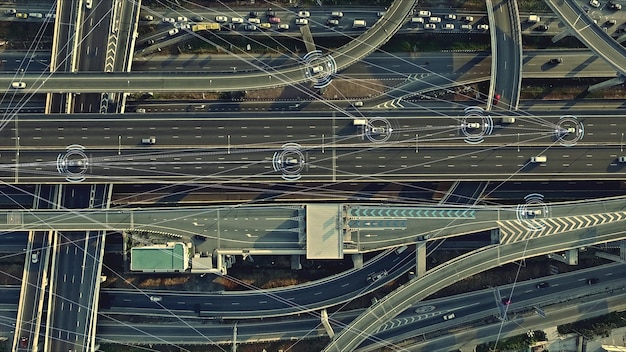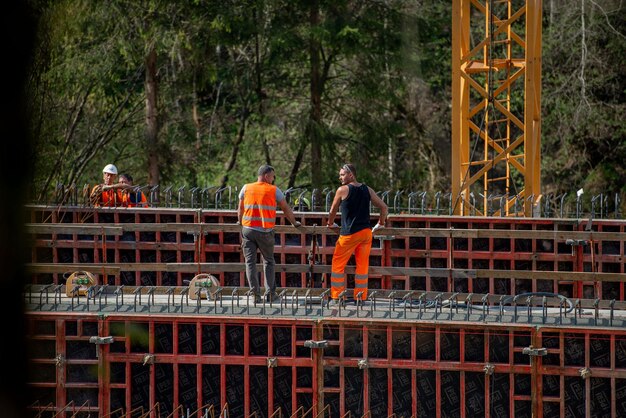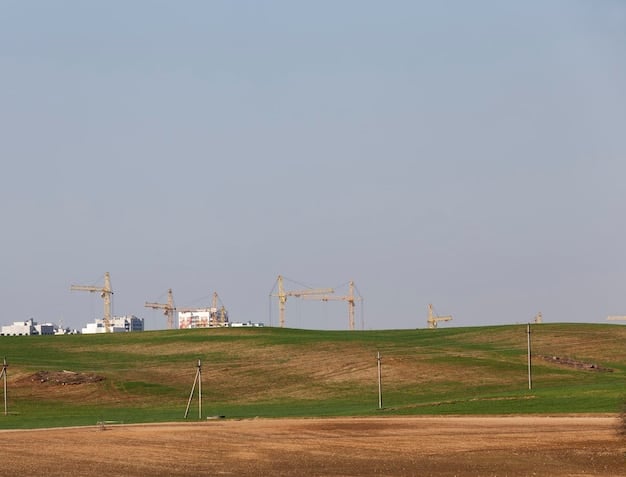Decoding the $1.2 Trillion Infrastructure Plan: Where Does the Money Go?

Decoding the President’s Infrastructure Plan: Where Will the $1.2 Trillion Go? This historic investment aims to modernize roads, bridges, and public transit, expand broadband internet access, and upgrade the nation’s power grid, promising significant economic and social benefits across the United States.
President Biden’s Bipartisan Infrastructure Law, a landmark $1.2 trillion package, promises to reshape America’s infrastructure landscape. Decoding the President’s Infrastructure Plan: Where Will the $1.2 Trillion Go? is a question on the minds of many as projects begin to take shape and communities anticipate the promised benefits.
Understanding the Bipartisan Infrastructure Law
The Bipartisan Infrastructure Law (BIL), officially known as the Infrastructure Investment and Jobs Act, represents a once-in-a-generation investment in the nation’s infrastructure. It addresses critical needs across various sectors, from transportation and energy to water and broadband.
Key Objectives of the Infrastructure Plan
The primary goal of the BIL is to modernize and expand the existing infrastructure, ensuring it meets the demands of the 21st century. This includes not only repairing aging systems but also building new infrastructure to support economic growth and improve quality of life.
- Modernize roads, bridges, and public transit systems.
- Expand access to clean drinking water and improve water infrastructure.
- Ensure access to reliable high-speed internet for all Americans.
- Upgrade the nation’s power grid to deliver clean, reliable energy.
The plan also focuses on creating jobs, stimulating economic growth, and enhancing the country’s competitiveness in the global market. By investing in infrastructure, the administration aims to lay the foundation for long-term prosperity and sustainability.
In summary, the Bipartisan Infrastructure Law is a comprehensive effort to upgrade America’s infrastructure, addressing critical needs and setting the stage for future economic growth and improved quality of life.
Transportation Infrastructure: Roads, Bridges, and Transit
A significant portion of the $1.2 trillion is allocated to transportation infrastructure. This includes funding for roads, bridges, public transit, and other vital transportation systems.

Road and Bridge Repair and Construction
The plan dedicates billions of dollars to repair and rebuild roads and bridges across the country. This investment aims to reduce traffic congestion, improve safety, and ensure the efficient movement of goods and people.
Investment in Public Transit
Public transit systems will receive substantial funding to modernize and expand their services. This includes upgrading buses, trains, and other transit vehicles, as well as improving accessibility for people with disabilities.
- Modernizing and expanding public transit options in urban areas.
- Improving accessibility for people with disabilities on public transit.
- Investing in electric vehicle charging infrastructure along major highways.
These investments are crucial for reducing reliance on personal vehicles, decreasing carbon emissions, and providing affordable transportation options for communities across the nation.
In conclusion, the transportation infrastructure component of the plan aims to modernize and expand the nation’s transportation systems, enhancing mobility, safety, and environmental sustainability.
Expanding Broadband Internet Access Nationwide
One of the key priorities of the infrastructure plan is to expand access to high-speed internet, particularly in rural and underserved areas. This initiative aims to bridge the digital divide and ensure that all Americans have access to the internet resources they need to participate in the modern economy.
Funding for Broadband Infrastructure Development
The plan allocates significant funding for building new broadband infrastructure, including laying fiber optic cables and deploying wireless technologies. This investment will help connect communities that currently lack access to reliable high-speed internet.
Affordability and Accessibility Initiatives
In addition to building infrastructure, the plan also includes initiatives to make internet access more affordable and accessible for low-income households. This includes subsidies and programs to help families pay for internet service.
- Providing subsidies to low-income households to afford internet service.
- Investing in digital literacy programs to help people use the internet effectively.
- Ensuring that internet access is available in schools, libraries, and community centers.
By addressing both infrastructure and affordability, the plan aims to ensure that all Americans can benefit from the opportunities provided by the internet.
Overall, the broadband internet access component of the plan seeks to bridge the digital divide, ensuring that all Americans have access to the high-speed internet resources they need for education, employment, and social inclusion.
Upgrading the Nation’s Power Grid for Clean Energy
Another vital component of the infrastructure plan is upgrading the nation’s power grid. This includes investments in renewable energy, energy storage, and grid modernization to ensure a reliable and sustainable energy supply.
Investing in Renewable Energy Sources
The plan allocates funding for developing and deploying renewable energy sources, such as solar, wind, and geothermal power. This investment will help reduce reliance on fossil fuels and mitigate the impacts of climate change.

Modernizing the Electrical Grid
The plan also focuses on modernizing the electrical grid to improve its reliability and resilience. This includes upgrading transmission lines, installing advanced metering infrastructure, and deploying smart grid technologies.
- Upgrading transmission lines to deliver renewable energy across the country.
- Installing advanced metering infrastructure to improve energy efficiency.
- Deploying smart grid technologies to enhance grid resilience and reliability.
By modernizing the grid and investing in renewable energy, the plan aims to create a cleaner, more reliable, and more resilient energy system for the future.
In summary, the power grid upgrade component of the plan focuses on transitioning to a clean energy economy, ensuring a sustainable and reliable energy supply for the nation.
Water Infrastructure: Ensuring Clean and Safe Drinking Water
Ensuring access to clean and safe drinking water is a major priority. The infrastructure plan includes significant investments in water infrastructure to address issues such as lead contamination, aging pipes, and water scarcity.
Replacing Lead Pipes and Addressing Contamination
One of the key focuses is on replacing lead pipes and addressing lead contamination in drinking water systems. This investment will help protect public health and ensure that all Americans have access to safe drinking water.
Investing in Water Infrastructure Improvements
The plan also includes funding for improving water treatment plants, repairing aging pipes, and developing new water sources. These investments will help ensure a reliable and sustainable water supply for communities across the country.
- Replacing lead pipes to prevent lead contamination of drinking water.
- Upgrading water treatment plants to improve water quality.
- Developing new water sources to address water scarcity in arid regions.
By addressing these critical issues, the plan aims to safeguard public health and ensure that all Americans have access to clean and safe drinking water.
Overall, the water infrastructure component of the plan aims to modernize and improve water systems, ensuring access to clean and safe drinking water for communities across the nation.
Economic Impact and Job Creation
The infrastructure plan is expected to have a significant economic impact, creating jobs and stimulating economic growth across various sectors. The investments in infrastructure will support construction, manufacturing, and technology industries, among others.
Creating Construction and Manufacturing Jobs
The plan will create numerous construction and manufacturing jobs as projects get underway. This includes jobs for engineers, construction workers, electricians, and other skilled tradespeople.
Stimulating Economic Growth in Local Communities
The investments in infrastructure will also stimulate economic growth in local communities. This includes increased demand for goods and services, as well as new business opportunities created by the infrastructure projects.
- Boosting job creation in construction, manufacturing, and technology sectors.
- Stimulating economic growth in local communities through infrastructure investments.
- Enhancing the country’s competitiveness in the global market.
By creating jobs and spurring economic growth, the plan aims to improve the economic well-being of Americans and enhance the country’s competitiveness in the global market.
In conclusion, the economic impact and job creation aspects of the plan are expected to be significant, fostering economic growth and improving the lives of Americans across the country.
| Key Point | Brief Description |
|---|---|
| 🛣️ Transportation | Modernizing roads, bridges, and public transit systems nationwide. |
| 🌐 Broadband Access | Expanding high-speed internet to rural and underserved areas. |
| ⚡ Power Grid | Upgrading the power grid for clean and reliable energy delivery. |
| 💧 Water Infrastructure | Ensuring clean and safe drinking water through infrastructure improvements. |
Frequently Asked Questions
▼
The Bipartisan Infrastructure Law (BIL) is a $1.2 trillion investment in the nation’s infrastructure, addressing critical needs across transportation, energy, water, and broadband sectors.
▼
The plan will modernize roads, bridges, and public transit systems, aiming to reduce congestion, improve safety, and enhance mobility for commuters and businesses.
▼
The goal is to bridge the digital divide by expanding high-speed internet access to rural and underserved areas, ensuring all Americans can participate in the modern economy.
▼
The plan focuses on replacing lead pipes, improving water treatment plants, and developing new water sources to ensure clean and safe drinking water nationwide.
▼
The plan is projected to stimulate economic growth by creating construction and manufacturing jobs, enhancing the country’s competitiveness, and improving general economic well-being.
Conclusion
In conclusion, decoding President Biden’s Infrastructure Plan reveals a comprehensive effort to modernize and upgrade critical infrastructure across the United States. With investments in transportation, broadband, energy, and water sectors, the plan promises significant economic, social, and environmental benefits for communities nationwide.





